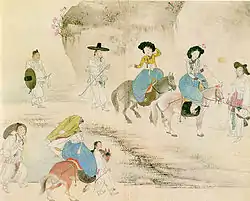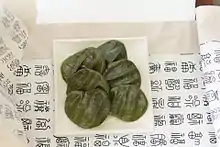Double Third Festival
The Double Third Festival (Chinese: 三月三; pinyin: sānyuèsān; Korean: 삼짇날; romaja: samjinnal) or Shangsi Festival (traditional Chinese: 上巳節; simplified Chinese: 上巳节; pinyin: shàngsìjié; Japanese: 上巳; rōmaji: jyōshi / jyōmi; Korean: 삼사; romaja: samsa) is an East Asian festival. The 2021 date is April 14.[1]
| Double Third Festival | |||||||||
|---|---|---|---|---|---|---|---|---|---|
| Chinese name | |||||||||
| Chinese | 三月三 | ||||||||
| Literal meaning | Third-month Third(-day) | ||||||||
| |||||||||
| Korean name | |||||||||
| Hangul | 삼짇날 | ||||||||
| Hanja | 三-- | ||||||||
| Literal meaning | "Third day" Day | ||||||||
| |||||||||
| Shangsi Festival | |||||||||
|---|---|---|---|---|---|---|---|---|---|
| Chinese name | |||||||||
| Traditional Chinese | 上巳節 | ||||||||
| Simplified Chinese | 上巳节 | ||||||||
| |||||||||
| Korean name | |||||||||
| Hangul | 상사 | ||||||||
| Hanja | 上巳 | ||||||||
| |||||||||
| Japanese name | |||||||||
| Kanji | 上巳 | ||||||||
| Kana | じょうし/じょうみ | ||||||||
| |||||||||
China
The Double Third or Shangsi Festival is an ancient Chinese festival celebrated on the third day of the third month of the Chinese calendar. During the festival people would go for an outing by the water, picnic, and pluck orchids. It is also a day for invoking cleansing rituals to prevent disease and get rid of bad luck. The day is also traditionally considered to be a possible birthday of the Yellow Emperor.[2]
The ancient traditions of Shangsi are mostly celebrated by a few local communities today, such as the ancient village of Xinye which holds elaborate ancestor worship ceremonies on this day.[3][4]
The great calligrapher Wang Xizhi mentions this festival in his famous work Preface to the Orchid Pavilion Poems, written in regard to the Orchid Pavilion Gathering during the Six Dynasties era.
This holiday is also celebrated in Korea, where it is called Samjinnal or sangsa, in Japan as Hinamatsuri.
Korea
| Samjinnal | |
|---|---|
 "Yeonso dapcheong" drawn by Hyewon which depicts an outing in spring. | |
| Observed by | Koreans |
| Type | Cultural |
| Significance | Marks arrival of spring |
| Date | 3rd day of the 3rd lunar month |
| Related to | Shangsi Festival, Hinamatsuri |
Samjinnal is one of sesi pungsok (세시풍속) or Korean traditional customs by season, which falls on the third day of the third month in the Korean lunar calendar. It was called samjil (삼질) in old Korean language and referred to as sangsa, wonsa (원사, 元巳), sungsam (중삼, 重三), sangje (상제, 上除) or dapcheongjeol (답청절, 踏靑節) in hanja. Samjinnal implies the overlapping of Sam (three). According to Choi Namseon, samjil was derived from the consonants of Samil, and Sangsa is defined as the first snake day of the 3rd lunar month.[5]
Customs

Samjinnal is the festive day that informs the arrival of spring. This day is known as the day the swallows came back from Gangnam and the day the snake came out from its winter sleep. It is also the day birds and butterflies start to appear. This day, in the North Gyeongsang region, seeing a snake signifies good luck, seeing a white butterfly means death that year, and seeing a yellow butterfly implies fortune. They say soybean paste brewed this day tastes especially good and houses are repaired. By conducting farm frugality, people pray for abundance.
During Samjinnal, people pick out azalea flowers and knead it with glutinous rice dough to make Hwajeon, a Korean traditional rice cake. Mung bean powder is used to make mung bean noodles, and is also occasionally used with the azalea flowers. By dyeing the mung bean powder with red water, a seasonal dish called Sumyeon can be prepared. Other than this, white bubble rice cakes made with red bean paste called Santteok, Goritteok made from glutinous rice, pine endodermis and mugwort, and Ssuktteok made from glutinous rice and mugwort leaves are eaten this day.
Nori (Folk games)
- Pulssaum (풀싸움)
- Pulgaksi noleum (풀각시놀음)
- Fortunetelling
- Hwajeon nori (화전놀이, 花煎--) - It literally means "flower pancake play".
References
Citations
- http://www.chinasage.info/festivals.htm
- Nedostup, R. Superstitious Regimes: Religion and Politics of Chinese Modernity Harvard University Press: Cambridge 2009
- Wang, Zhi-han (12 February 2006). "Cultural Investigation of March 3rd Festival in Xinye Village". Journal of Anhui Institute of Education.
- 新叶村祭祖盛典 一个宗族790多年的坚守 (in Chinese). Sohu. 6 September 2010.
- http://www.lifeinkorea.com/culture/festivals/festivals.cfm?Subject=Samjinnal
Bibliography
- "The Food on Samjinnal". Korea Agro-Fisheries Trade Corporation. Retrieved 2008-06-28.
- Chung, Hyeon-Mi (정현미). "(진달래 음식의 종류와 조리법 고찰) The Kind and Recipe of Korean Rosebay Food" (PDF) (in Korean, English, and Japanese). National Folk Museum of Korea. pp. 1–16p. Retrieved 2008-06-28.
- 전주전통문화센터, 모악산 대원사, 전주공예품전시관 삼짇날 축제 (in Korean). Jeonju Traditional Cultural Center. 2008-04-02. Retrieved 2008-06-28.
- 봄을 즐기는 ‘삼월 삼짇날’ (in Korean). miz.co.kr. Retrieved 2008-06-28.